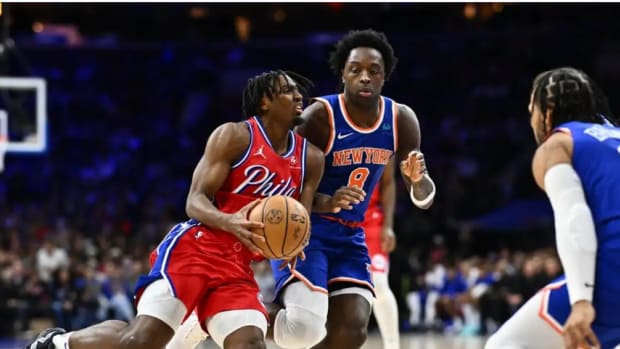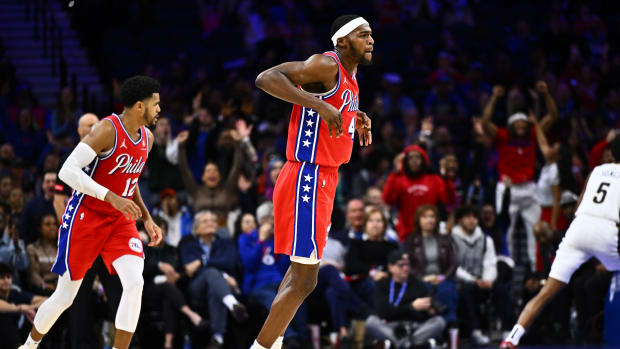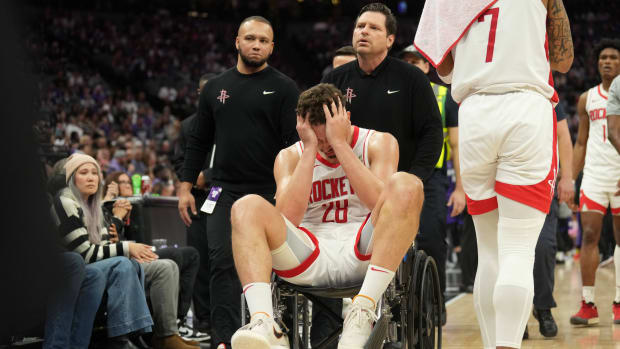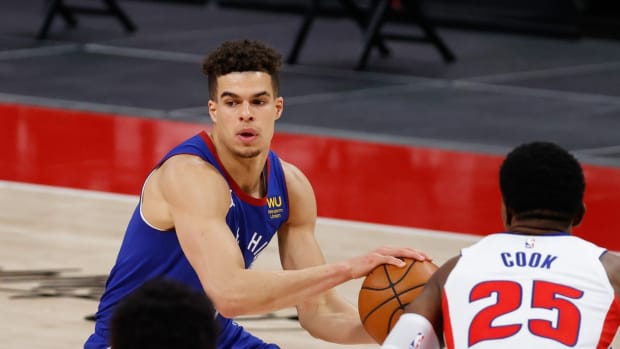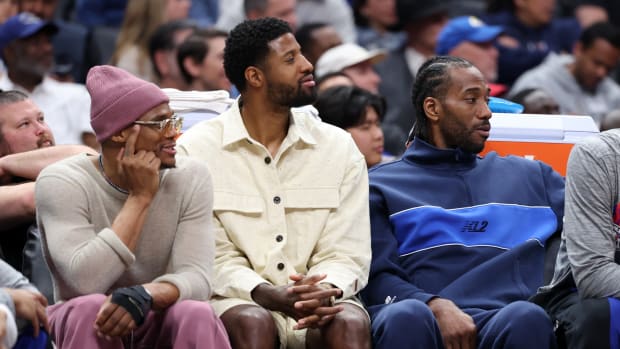Analysis: Why Derrick Rose Was Found Not Liable
After convening for three hours, a federal jury of six women and two men on Wednesday found New York Knicks guard Derrick Rose not liable for sexual battery and related civil offenses. The 28-year-old Chicago native will thus not be ordered to pay Rose’s accuser—whom Sports Illustrated and other media outlets refer to as “Jane Doe” in light of her status as an alleged victim of sexual violence—any money in damages. Doe sought $21.5 million in the case.
In a civil case such as Doe v. Rose, the burden of persuasion is the “preponderance of evidence” or, more colloquially, “more probable than not.” Put another way, jurors can only impose liability if they collectively believe that the defendant is probably liable to the plaintiff. This jury thus found Doe’s depiction of facts less believable than the account offered by Rose and his two co-defendants, Ryan Allen and Randall Hampton.
Doe maintained that Rose, whom she previously dated, along with Allen and Hampton broke into Doe’s Los Angeles apartment in August of 2013 and gang raped her while she was intoxicated and incapable of offering consent. Her account was chilling and depicted the three men as sexual predators.
Derrick Rose, associates cleared in civil rape trial
Rose, in stark contrast, insisted that Doe was sufficiently sober to offer consent and, through her texts and conduct, provided consent. To bolster that point, Rose portrayed Doe as having aggressively solicited him to have sex. Rose’s attorneys also highlighted how Doe sent text messages to Rose following the incident that focused on taxi fare reimbursement and other mundane topics that were arguably unlikely to be raised by someone who had just been raped. In addition, Rose’s attorneys exposed problems in Doe’s account as Doe, while on the stand, admitted to embellishing certain facts and that her relationship with Rose was less substantial than she originally portrayed.
There was limited physical evidence in this case since Doe did not seek medical attention or alert the Los Angeles Police Department. Jurors were thus focused on which narrative sounded more believable. Their verdict indicates that they found Rose’s depiction likely to be true.
Doe can appeal
Doe can appeal the judgment to the U.S. Court of Appeals for the Ninth Circuit. In an appeal, Doe must offer more than an mere assertion that the “jury got it wrong.” Doe must identify an alleged mistake of law made by U.S. District Judge Michael Fitzgerald while presiding over the trial. Along those lines, expect Doe to contend that Judge Fitzgerald erred in how he denied Rose’s motion for a mistrial. While Judge Fitzgerald denied Rose’s motion, he permitted the jury to hear and be influenced by the reason for the motion—that Doe failed to share a text message. As another possible source of appeal, Doe might contend that Judge Fitzgerald provided the jury with misleading or confusing instructions and those instructions led the jury to misapply the law.
An appeal would take many months to play out. Civil appeals in the Ninth Circuit generally take between 15 months and 32 months before a decision is rendered. An appeal, however, would not require the active participation of Doe or Rose. An appeal would involve attorneys for both sides submitting briefs about questions of law and, later, those attorneys delivering oral arguments in a hearing before a three-judge panel. The appellate process involves neither witness testimony nor examination of evidence. In addition, the three-judge panel would accord high deference to the trial court’s findings of facts, meaning Doe wouldn’t be able to re-litigate the facts presented against him during trial.
Whether Doe has the financial wherewithal to wage an appeal is unknown. Appeals can be very expensive, and cost thousands of dollars. While Doe’s fee agreement with her lead attorneys, Waukeen McCoy and Brandon Anand, is private, there is a good chance her attorneys took the case on a contingency fee basis. Under such an agreement, the attorneys are only paid if they win or they negotiate a settlement. It is unclear if McCoy and Anand would be willing to now take the case on appeal.
Rose could still face criminal charges, but almost certainly won’t
Any media story that reports Wednesday’s verdict as Rose being found not guilty of rape is wrong on several counts. First, he has not been found “not guilty,” a phrase that is reserved for criminal trials. He has been found not liable. Second, he did not face the criminal charge of rape. He instead faced several civil claims, including sexual battery, battery, trespass, violation of California’s gender violence law and intentional infliction of emotional distress. A jury found it less probable than not that Rose is liable for these claims. The jury was not asked to find whether it is beyond a reasonable doubt that Rose committed a crime.
Although it is now extremely unlikely, Rose could still be charged with a crime. Under the relevant California law, a person can be charged for sexual assault up to six years following an alleged incident. This means that Rose could be charged at anytime from now until August 2019.
“Could” is the operative word. The odds that Rose will be charged are exceptionally low. The trial proceeded as expected—the star witnesses provided conflicting statements about what happened and the attorneys debated how to interpret contrasting text messages. The trial likely did not reveal evidence that law enforcement hasn’t already considered and deemed insufficient to bring charges. The fact that Rose was found not liable in a civil case—with its lower burden of persuasion than in a criminal prosecution—would make it highly dubious for law enforcement to now charge Rose with sexual battery and expect to prove the case beyond a reasonable doubt.
An odd development occurred during the trial that connects it to the criminal investigation. LAPD detective Nadine Hernandez, who had investigated the alleged rape, was found dead on Oct. 11 of what appears to be a self-inflicted gunshot wound to the chest. Hernandez attracted attention when a Sept. 22 letter she wrote to an attorney for Doe became public. In her letter, Hernandez confirmed that the Rose investigation remains current and open. Hernandez’s death has prompted conspiracy theories and Internet speculation, but there is no evidence to connect her death to Rose in any way.
Detective investigating Derrick Rose rape allegation dies of gunshot wound
Whether the NBA punishes Rose is a complicated issue
Even though Rose was found not liable, commissioner Adam Silver is authorized to punish Rose under Article 35 of the NBA’s constitution. Article 35 empowers a fine or suspension for any “conduct that does not conform to standards of morality or fair play, that does not comply at all times with all federal, state, and local laws, or that is prejudicial or detrimental to the NBA.” Silver could justify suspending Rose on grounds that Rose’s conduct, even when viewed in the best light possible, did not “confirm to standards of morality.” He offered head-scratching testimony at times before and during the trial. This was particularly evident with his now infamous “we men” remark, which was prompted by an attorney’s question to Rose about why he, Allen and Hampton went to Doe’s apartment. It is safe to say the Rose controversy has been “detrimental to the NBA,” particularly in the wake of Rolling Stonedeleting a story about Rose and domestic violence after the NBA reportedly complained to the publication about the story. The NBA may also question why Rose would not try to settle the case before it attracted public notice and substantial controversy for the league.
The NBA has suspended players for domestic violence related offenses. Earlier this month, the NBA suspended Sacramento Kings guard Darren Collison eight games after he pleaded guilty to a misdemeanor domestic violence charge. In 2014, Silver suspended Charlotte Hornets Jeffrey Taylor for 24 games—29% of the regular season—after Taylor pleaded guilty to misdemeanor domestic violence assault and malicious destruction of hotel property. Taylor was accused of shoving a woman across a hotel hallway, causing her head and arm injuries. In 2007, then-commissioner David Stern suspended Sacramento Kings guard Ron Artest for seven games after Artest pleaded no contest to a domestic violence charge. It is also within a team’s authority to punish its players for off-court misconduct. A few years ago, the Boston Celtics suspended forward Jared Sullinger for one game after he admitted to team officials that he exercised poor judgment in an argument with his girlfriend. Sullinger faced criminal charges for the incident, but those charges were dropped.
There are at least three key distinctions between the situations of those four players—Collison, Taylor, Artest and Sullinger—and that of Rose. First, all four players were charged with crimes and navigated through the criminal justice system. Rose, for his part, won a civil lawsuit. He also was not charged with a crime and, as explained above, almost certainly won’t be charged. Second, all four players admitted to making a mistake and expressed a desire to improve their conduct. Rose insists that he did nothing wrong and the jury verdict appears to vindicate his insistence. Third, while all five players were implicated in acts of violence against women, Rose is the only one accused of having sexual intercourse without the woman’s consent. In that respect, the Rose case may be viewed as more worrisome than those of the other players.
Rose’s situation is also unique in that the NBA has not suspended players in the aftermath of civil lawsuits, let alone ones where the player wins. This is mainly because a lawsuit is, obviously, a less serious legal matter than a criminal prosecution. Further, in many cases, a lawsuit centers on a matter that tends not to elicit social outrage. It might concern a business dispute, an alleged breach of contract, a personal injury or a divorce or paternity quarrel. These are serious matters in their own right, but lower on the spectrum of what NBA fans—and the NBA’s sponsors—take notice of. Yet Rose’s lawsuit has attracted greater significance because it centers on a deeply disturbing accusation: that he and two other men broke into a woman’s apartment and took turns having sex with her without her consent. From this light, Rose’s legal matter, while civil in form, could be considered closer to a criminal prosecution in terms of importance. On the other hand, Rose and others would argue that winning the lawsuit ought to be viewed as tantamount to him being cleared.
Adding a further complication, the Rose case has occurred while the NBA and NBPA are reportedly nearing an agreement on a new collective bargaining agreement. The current CBA is set to run through the 2020-21 season, but either side can exercise an opt-out clause on or before Dec. 15, 2016. If the opt-out occurs, the current CBA would end on June 30, 2017, and a lockout would likely begin on July 1, 2017. Both sides have reason to opt-out of the current CBA, but it appears they will avoid any labor dispute by negotiating a new CBA.
Rose’s situation may seem like a peripheral issue in CBA talks and, given the totality of issues in the CBA, it probably is. But Rose’s situation nonetheless connects to the league’s disciplinary policy and how the policy addresses actual and alleged acts of violence against women. Under the terms of the current CBA, and specifically Article VI, Silver can suspend players for 10 or more games if they are convicted of, or plead guilty to, violent felonies. At first glance, Article VI appears to be a severely limiting condition for the NBA: attorneys can often strike plea deals with prosecutors so that their clients plead guilty to misdemeanors rather than felonies. Thus, if an NBA player pleads guilty to a misdemeanor, he would fall outside the scope of Article VI. It therefore stands to reason the NBA may demand less restrictive disciplinary language in the next CBA.
On the other hand, the NBA regards Article VI as merely providing a minimum punishment for when a player is convicted of, or pleads guilty to, a violent felony. From that lens, Article VI does not preclude punishments for misdemeanors and perhaps for—as with Rose—alleged civil offenses, even alleged offenses that are unproven in court. Moreover, the NBA smartly negotiated that Article 35 (discussed above) of the League constitution be specifically referenced and incorporated into the collectively bargained Uniform Player Contract. In short, the NBA would seem to be within its authority to punish Rose.
Nevertheless the lack of precedent of NBA players being punished in the aftermath of winning a civil lawsuit could prompt the NBPA to object to any punishment of Rose. Perhaps the NBPA might go so far as to demand changes in a new CBA and removal or modifying of Article 35 as it is applies to the Uniform Player Contract. While those scenarios seem unlikely, the last thing the NBA and NBPA want is a new controversy to surface right as they near the finish line on a new CBA. How the NBA chooses to handle the Rose situation should thus be viewed as occurring within the context of CBA talks.
Adidas could seek to suspend or terminate Rose’s endorsement contract
Along with others, I was surprised that Rose did not attempt to negotiate a settlement with Doe months before the case attracted substantial attention. Even though Rose has won the lawsuit and is vindicated, the mere allegation of rape, coupled with other unflattering and newsworthy aspects of the case, could have damaged Rose's reputation and suggested that he would have been better off paying Doe an amount of money in exchange for her dropping the lawsuit. Attorneys for Doe, however, consistently claimed that Rose’s attorneys were unwilling to engage in settlement talks and, in fact, wouldn’t respond to emails.
Officials at Adidas, which signed Rose to a 13-year, $185 million endorsement deal, are likely now discussing how to best handle Rose’s situation. The logic behind an endorsement deal is that the athlete’s association with a brand will make consumers more likely to purchase that brand’s products. The endorsement of Rose, a talented NBA player, of a basketball product signals to consumers who are evaluating different basketball products that the Rose-endorsed product is worth buying. Rose being found liable in a high-profile sexual battery case does not, on the surface, undermine the credibility of Rose endorsing an Adidas product. Rose remains the same talented and knowledgeable basketball player today as he was yesterday.
Yet product endorsements do not work so neatly. Consumers—and especially consumers who are parents of children that desire a particular product—also take notice of the reputation of the endorser and his or her values. Even if Rose continues to be an authoritative voice on basketball, he is now associated with a case that many fans regard as a rape case. At a minimum, the case portrays Rose as displaying questionable judgment; at worst, it raises serious questions about his view of women and understanding of consent—a word, by the way, that he curiously claims he does not understand.
Rose’s contract with Adidas is a private document, but it almost certainly contains a “morals clause.” This is a standard provision that, if triggered, enables the company to suspend or extinguish its remaining financial obligations to the player. Language from another player’s endorsement contract with a major company reads as follows:
The athlete must act at all times with due regard to public morals and conventions and the company can suspend or terminate the deal if the athlete commits an offense involving moral turpitude under federal, state or local laws or which brings the athlete or company into public disrepute, contempt, scandal or ridicule, or which insults or offends the community.
Assuming Rose’s contract contains similar language, Adidas might reason that Rose’s conduct clearly falls within the prohibited language. Note that Rose being found not liable does not remove the possibility of Adidas invoking the clause. Further, Adidas might conclude that consumers will primarily associate Rose not with his basketball prowess but with being a defendant in a sexual battery case, albeit one that he won. More cynically, Adidas might also take advantage of Rose’s legal troubles to part ways with a player whose best days on the court may be behind him. The company could reason that Rose, who is now 28-years-old, is no longer the same all-star player he was prior to suffering a devastating knee injury in 2012. His numbers over the previous three seasons were decidedly inferior to numbers he accumulated during his first four NBA seasons. Arguably, Rose is less marketable as a basketball player to consumers than he was years ago—if Adidas reaches that conclusion, it would have another reason, albeit not one that it would publicly mention, to invoke the morals clause.
Adidas, however, may decide not to invoke the morals clause. Most obviously, Rose won the lawsuit and, from that lens, has been vindicated. Also, other players who have endorsement deals with Adidas might object on grounds that it is excessive to invoke in the aftermath of Rose winning the trial. Those players may be less inclined to remain with Adidas when their contracts are set to expire. Further, Adidas might encounter more difficulty recruiting new players to sign, as Adidas’ competitors could attempt to persuade those players that Adidas showed disloyalty by how it treated Rose.
Rose could also sue Adidas for breach of contract if the company invokes a moral clause. Rose could insist that being the defendant in a civil trial, particularly one in which he prevails, should not trigger such a punitive result. He might also insist Adidas’ true motivations are to part ways with an aging player and that the company is using the sexual battery case as pretext to exit the endorsement contract.
Other players have sued over a company’s invocation of a morals clause. Most notably, former Pittsburgh Steelers running back Rashard Mendenhall—whose controversial tweets following Osama Bin Laden’s death in May 2011 led Hannesbrand to drop him as an endorser—sued Hannesbrand over the applicability of a morals clause to his politically-controversial tweets. In a series of tweets, Mendenhall questioned the merits of killing Bin Laden and also gave credence to conspiracy theories about 9/11. Mendenhall and Hannesbrand ultimately settled their legal dispute out of court.
SI.com will keep you updated on all key developments in the aftermath of Wednesday’s verdict in the Rose case.
Michael McCann, SI's legal analyst, is a Massachusetts attorney and the founding director of the Sports and Entertainment Law Institute at the University of New Hampshire School of Law.































